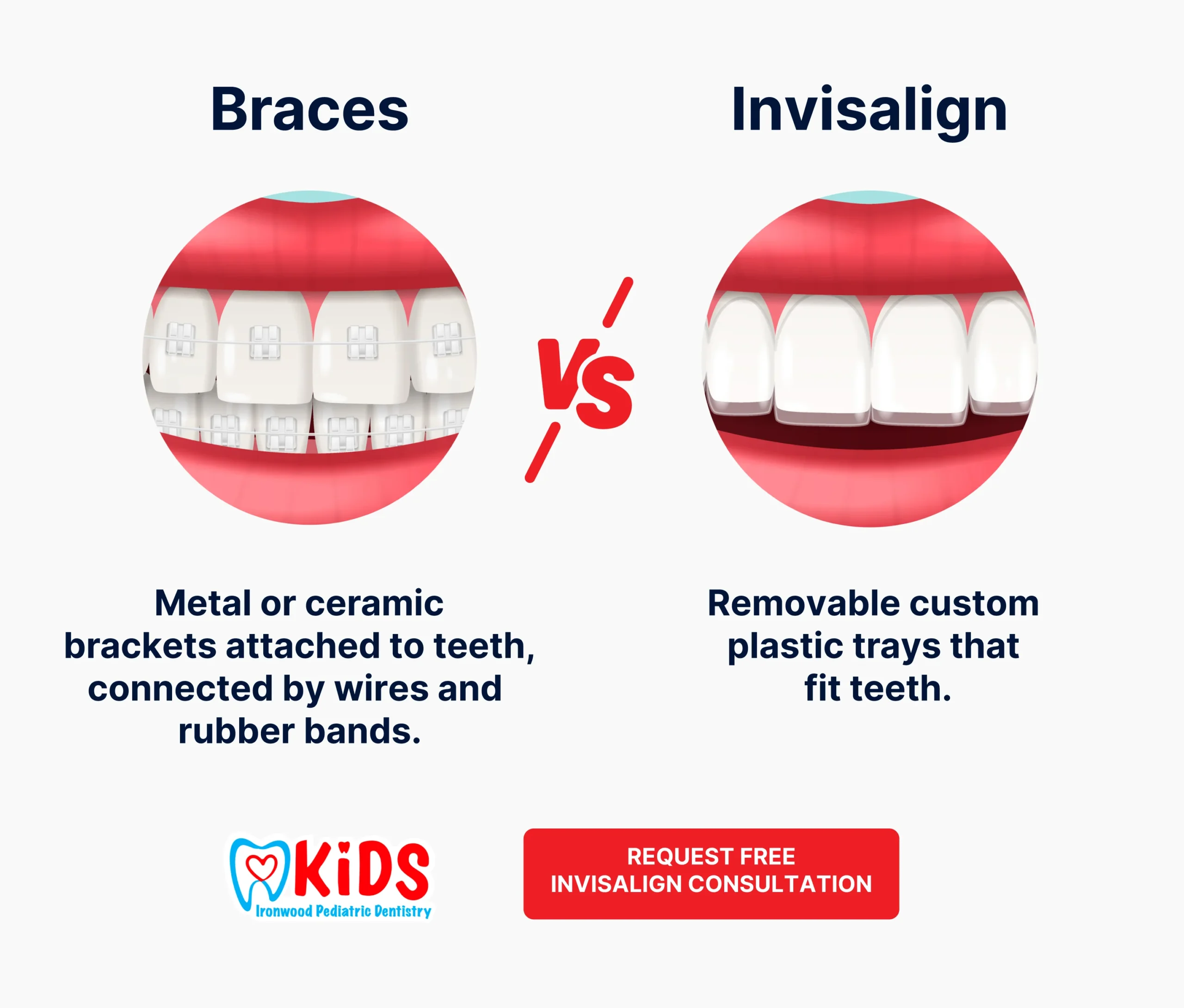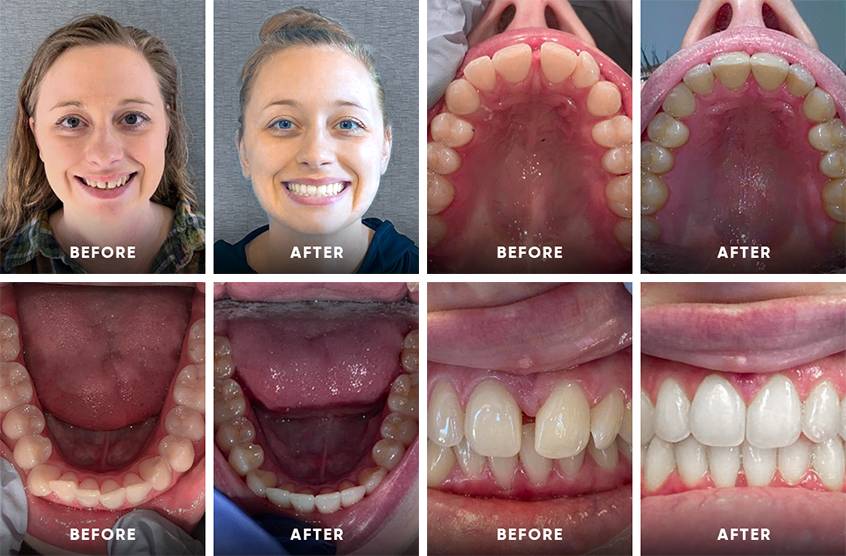Discover the Perks of Invisalign for a Perfect Smile Makeover
Discover the Perks of Invisalign for a Perfect Smile Makeover
Blog Article
Invisalign vs. Traditional Braces: Which Alternative Is Right for You?
When thinking about orthodontic treatment, the selection between Invisalign and typical dental braces provides numerous important elements that warrant careful evaluation. Invisalign supplies a discreet alternative with removable aligners, while conventional dental braces give an extra visible yet reliable service for extreme imbalance. Each choice incorporates distinctive advantages and downsides connected to aesthetics, convenience, treatment duration, and expense. Understanding these subtleties is important for making a notified choice that lines up with your individual preferences and lifestyle. The inquiry remains: which alternative will ideal satisfy your orthodontic needs and expectations?
Summary of Therapy Choices

In comparison, conventional dental braces contain metal braces and cables that are bonded to the teeth. This approach uses constant pressure with time to attain alignment. While reliable for complex orthodontic problems, typical dental braces require normal sees for modifications and can present challenges in keeping dental health because of the problem of cleaning around braces and cables.
Both options have their values, and the selection frequently depends upon particular oral problems, lifestyle preferences, and person compliance. Eventually, speaking with an orthodontic expert is important for figuring out one of the most appropriate therapy strategy tailored to private demands. Understanding the nuances of each alternative can dramatically affect the overall success of orthodontic therapy.
Visual Factors To Consider
A significant variable influencing the selection between Invisalign and standard dental braces is the aesthetic allure each therapy offers. Invisalign aligners are crafted from clear plastic, making them essentially unseen when used.
On the other hand, traditional braces consist of steel brackets and cables, which can be extra obvious. While innovations in orthodontic modern technology have resulted in the development of smaller braces and tinted elastics, traditional dental braces still maintain a more noticeable profile. For some people, the presence of dental braces may hinder them from looking for required treatment.
Eventually, the selection in between Invisalign and typical dental braces might rest on individual choices relating to appearances. People that focus on discernment often favor Invisalign, while those that are much less worried about visibility may choose standard dental braces. Comprehending the aesthetic implications of each choice is crucial for making an educated choice that straightens with one's lifestyle and preferences.
Comfort and Convenience

In terms of comfort, Invisalign aligners are detachable, making it possible for patients to enjoy their preferred foods without limitation and maintain ideal dental hygiene. Cleaning and flossing are streamlined, as the aligners can be secured throughout these routines, whereas typical dental braces need mindful navigating around braces and wires.
In comparison, conventional braces require routine modifications, making them much less hassle-free for those with hectic routines. In general, the convenience and comfort of Invisalign make it an appealing option for many people seeking orthodontic treatment.
Therapy Duration and Efficiency
While both Invisalign and traditional dental braces are efficient in correcting dental imbalances, the duration of treatment can vary substantially between the two options. Generally, Invisalign treatment can take anywhere from 12 to 18 months, depending upon the complexity of the case. The clear aligners function by progressively shifting teeth right into their wanted placements, and routine follow-ups with an orthodontist help guarantee progression remains on the right track.
On the other hand, standard braces usually require a longer dedication, usually ranging from 18 months to three years. This results from their fixed nature and making use of wires and braces, which can be extra reliable for serious imbalances and complex situations (Invisalign). The treatment efficiency of typical dental braces is well-documented, as they permit accurate modifications and higher control over tooth movement
Inevitably, the choice between Invisalign and standard braces might depend upon both the anticipated treatment period and the details dental find more info issues at hand. Consulting with an orthodontist is important, as they can provide customized recommendations based upon specific demands, ensuring the picked method lines up with preferred durations and outcomes.
Price Contrast and Insurance Coverage Choices
Expense plays a considerable role in the decision-making procedure for individuals thinking about orthodontic therapy, whether choosing Invisalign or traditional braces. On average, the expense of Invisalign ranges from $3,000 to $8,000, while traditional braces usually set you back between $2,000 and $6,000. Aspects influencing these expenses include the intricacy of the situation, the period of therapy, and geographical area.
Insurance insurance coverage can significantly impact out-of-pocket expenditures. Several dental insurance coverage strategies recommended you read supply partial coverage for orthodontic therapies, but the specifics can vary commonly. It is important for individuals to examine their insurance coverage to figure out the extent of protection for either choice. Normally, standard dental braces might be more regularly covered by insurance policy plans compared to Invisalign, which some insurance companies categorize as an aesthetic treatment.
In addition, numerous orthodontic techniques provide flexible payment plans, making both treatment choices much more available. Patients ought to ask about prospective funding alternatives and price cuts for ahead of time payments. Assessing the total expense, including insurance benefits and layaway plan, is important for making a notified choice that straightens with both visual preferences and spending plan considerations.

Verdict
In recap, the choice in between Invisalign and conventional braces pivots on several elements, consisting of aesthetic choices, convenience, therapy duration, and cost. Invisalign provides a discreet, removable alternative that promotes dental health and nutritional flexibility, while typical braces might be better for complex oral issues and frequently come at a lower cost factor. Inevitably, assessment with an orthodontist is necessary to examine specific scenarios and identify the most suitable treatment option for accomplishing ideal oral positioning.
When thinking about Visit Your URL orthodontic treatment, the option between Invisalign and traditional braces offers numerous essential aspects that warrant careful examination.Contrasting Invisalign and typical dental braces reveals distinct treatment choices for orthodontic correction.While both Invisalign and traditional dental braces are effective in remedying oral imbalances, the duration of therapy can vary substantially in between the 2 choices.Price plays a significant function in the decision-making process for people taking into consideration orthodontic treatment, whether deciding for Invisalign or standard dental braces.In recap, the selection in between Invisalign and traditional braces pivots on several factors, consisting of aesthetic preferences, convenience, therapy period, and cost.
Report this page